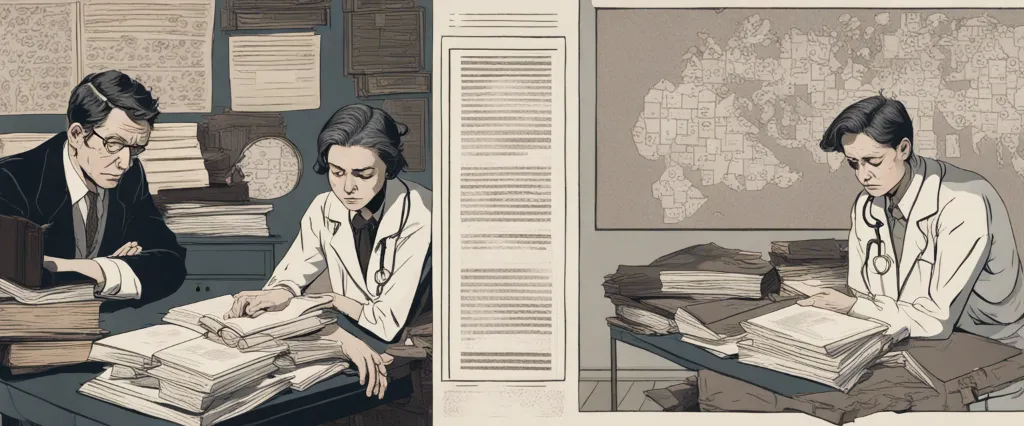
In “Survival of the Sickest” by Sharon Moalem, the human body is viewed through a new lens that challenges conventional wisdom about health, disease, and evolution. Moalem, a renowned medical doctor and geneticist, combines scientific knowledge with captivating storytelling to explore how certain genetic traits that we perceive as detrimental are actually advantageous for survival. By unraveling the mysteries behind diseases such as hemochromatosis and diabetes, Moalem uncovers the hidden ways in which our evolutionary past shapes our present health.
Chapter 1: The Genetic Basis of Survival
Chapter 1 of “Survival of the Sickest” by Sharon Moalem discusses the fascinating relationship between genetic disorders and evolutionary advantage. Moalem explores the concept that certain diseases and conditions, which may seem detrimental to our health, actually provide an advantage in certain situations and therefore persist in our genetic makeup.
The chapter begins with a discussion on hemochromatosis, a disorder that causes excessive iron absorption in the body. While this condition can lead to severe organ damage if left untreated, it is surprisingly prevalent in certain populations, particularly people of Celtic descent. Moalem explains that the high occurrence of hemochromatosis among the Celts is likely due to the advantage it provided in ancient times when iron-rich food sources were scarce.
The author then introduces the topic of malaria and its relationship with another genetic disorder called sickle cell anemia. While sickle cell anemia can be a debilitating and life-threatening disease, it is also prevalent in regions where malaria is widespread, such as sub-Saharan Africa. Moalem explains that individuals carrying the sickle cell trait have an increased resistance to malaria, providing them with a survival advantage in environments where this infectious disease is rampant.
The chapter goes on to discuss how other genetic diseases, like cystic fibrosis and glucose-6-phosphate dehydrogenase (G6PD) deficiency, can potentially provide some form of resistance against other diseases or offer certain benefits in specific circumstances.
In summary, Chapter 1 of “Survival of the Sickest” examines the intriguing connection between genetic disorders and survival advantages throughout human history. Moalem emphasizes that even though these diseases may have negative health consequences, they have persisted in our genetic makeup due to the benefits they provide in certain situations. This chapter sets the stage for an exploration of the complex relationship between genetics, evolution, and health in the rest of the book.
Chapter 2: Evolutionary Adaptations and Disease
Chapter 2 of “Survival of the Sickest” by Sharon Moalem explores the concept of evolutionary adaptations and their relevance to human disease. Moalem argues that certain diseases that afflict humans today may actually have been advantageous in the past, allowing our ancestors to survive and reproduce in particular environments.
The chapter delves into various examples of this idea, beginning with the alarming statistic that individuals with hemochromatosis, a genetic condition that leads to excessive iron absorption, were less likely to contract the bubonic plague. Moalem hypothesizes that the increased iron levels in their blood made it less hospitable for the bacteria that caused the disease.
Next, the author examines the connection between malaria and sickle cell anemia. People with sickle cell trait, which can lead to the disease in extreme cases, have an increased resistance to malaria. This highlights how natural selection favored individuals who carried the sickle cell trait in regions where malaria was prevalent.
Another notable example is the increased susceptibility to pneumonia in individuals with cystic fibrosis. This genetic disorder causes the production of thick mucus, making them more susceptible to respiratory infections. However, recent research suggests that the excessive production of mucus might have once offered protection against certain diseases prevalent in cold and damp environments.
Overall, the chapter argues that many diseases could have conferred a survival advantage in ancient times, yet they persist today due to changes in our environment and lifestyle. Moalem emphasizes that understanding these evolutionary adaptations can enhance our understanding of disease mechanisms and potentially lead to more effective treatments and preventive measures.
Chapter 3: Genetic Mutations and Human Resilience
Chapter 3 of “Survival of the Sickest” by Sharon Moalem, titled “Genetic Mutations and Human Resilience,” explores the fascinating relationship between genetic mutations and their impact on human health and survival. Moalem delves into various examples where seemingly harmful genetic mutations have paradoxically provided advantages in specific situations, ultimately helping individuals and populations to survive.
The chapter begins by discussing the role of a gene called hemochromatosis (HFE), which leads to the accumulation of excess iron in the body. While this condition can be fatal, Moalem highlights that in regions where malaria is prevalent, individuals with HFE mutations actually have a higher chance of survival. This is because the malaria parasite requires iron to survive, and by overloading the body with iron, the mutation inadvertently starves the parasite, enhancing the individual’s resilience against the disease.
Moalem further explores genetic mutations that relate to cholesterol levels. He introduces the example of familial hypercholesterolemia, a condition that causes dangerously high cholesterol levels. Paradoxically, individuals with this condition have been found to have a reduced risk of heart attacks, as cholesterol is necessary to fight off certain infections.
The chapter then delves into the role of genetic mutations in cancer. Moalem discusses the p53 gene, known as the “guardian of the genome,” which helps prevent the growth of cancerous cells. In some cases, however, mutations in this gene can actually lead to better outcomes for patients with certain types of cancer, such as lung cancer. These mutations make cancer cells more susceptible to treatment, increasing the chances of survival.
Overall, Chapter 3 of “Survival of the Sickest” highlights the complex interplay between genetic mutations, diseases, and human resilience. It explores instances where seemingly detrimental mutations have provided advantages in specific situations, shedding light on the intricate mechanisms of evolution and survival.
Chapter 4: Infectious Diseases and Immune Responses

In Chapter 4 of “Survival of the Sickest” by Sharon Moalem, titled “Infectious Diseases and Immune Responses,” the author explores the relationship between infectious diseases and their impact on our immune system. Moalem argues that certain diseases may have beneficial effects, despite their negative impact on human health.
The chapter begins by discussing the measles, a highly contagious disease that has infected countless individuals throughout history. Contrary to popular belief, measles may have a positive side as it has evolved to coexist with humans, providing benefits in the long run. Measles, being an airborne virus, continually challenges our immune system, helping it to stay strong and functional.
Moalem then delves into the concept of “evolutionary arms races” between pathogens and the immune system. Infectious diseases, such as tuberculosis and malaria, have a long history of causing significant damage, but they have shaped our immune responses over time. Our immune systems have evolved alongside these diseases, developing powerful defense mechanisms to combat them. Therefore, while these diseases can be lethal, they have also been a driving force behind the evolution of our immune system.
The chapter also highlights how certain genetic variations, such as those resulting in sickle cell anemia and HIV resistance, are related to protection against infectious diseases. Sickle cell anemia, despite its negative impact on individuals, also provides resistance against malaria. Similarly, certain individuals possess genetic variations that make them less susceptible to contracting HIV.
Overall, Chapter 4 reveals how infectious diseases and our immune responses have a complex relationship. While diseases can be detrimental to our health, they have played a crucial role in shaping our immune system and led to the development of protective genetic variations. Understanding this intricate balance between pathogens and our immune system offers valuable insights into both disease prevention and treatment methods.
Chapter 5: Genetic Diversity and Survival Strategies
Chapter 5 of “Survival of the Sickest” by Sharon Moalem explores the concept of genetic diversity and its role in human survival. Moalem argues that genetic diversity is essential for species to adapt and thrive in changing environments, and human evolutionary history is shaped by various survival strategies.
The chapter begins by discussing the importance of genetic diversity in preventing diseases. Genetic diversity provides a population with a wider range of immune defenses, making it more resistant to infectious diseases. The author uses examples such as sickle cell anemia and Cystic fibrosis to explain how these seemingly disadvantageous genetic variations can offer protection against deadly illnesses like malaria or cholera.
Moalem then delves into the impact of genetic diversity on fertility and reproductive success. He highlights the phenomenon of consanguinity, or mating between close relatives, which can lead to an increased prevalence of recessive genetic disorders. In contrast, outbreeding, or mating between genetically different individuals, promotes genetic diversity and helps eliminate harmful recessive disorders from the population.
The chapter also explores the concept of sexual reproduction as a survival strategy. Sexual reproduction, unlike asexual reproduction, increases genetic diversity by mixing and combining genetic material from two parents. This diversification offers a greater chance of survival and adaptation for the offspring in unpredictable environments.
Furthermore, Moalem emphasizes the role of genetic diversity in evolutionary strategies. Selective breeding, human migrations, and hybridization events between different populations over time have contributed to genetic diversity and the survival of our species.
In summary, Chapter 5 of “Survival of the Sickest” explores how genetic diversity plays a crucial role in the survival and adaptation of humans. It explains how seemingly disadvantageous genetic variations sometimes offer protection against deadly diseases, the importance of outbreeding to prevent recessive disorders, and how sexual reproduction enhances genetic diversity. Overall, the chapter emphasizes the significance of genetic diversity as a fundamental aspect of human survival strategies and evolutionary success.
Chapter 6: The Role of Genetics in Human History
Chapter 6 of “Survival of the Sickest” by Sharon Moalem delves into the profound influence genetics has had on human history. Moalem begins by explaining how the spread of diseases, such as malaria and sickle cell anemia, has shaped human evolution.
Malaria, a widespread and deadly disease, has played a crucial role in shaping genetic diversity among humans. The genetic mutation that causes sickle cell anemia, while detrimental in its full form, offers protection against malaria. This resulted in a higher prevalence of the sickle cell trait in regions where malaria is prevalent, such as Sub-Saharan Africa. Moalem aptly describes this evolutionary trade-off between the risks of sickle cell anemia and the benefits of malaria resistance.
Moreover, the chapter explores the impact of genetics on survival during historical catastrophes. For instance, during the Black Death, which devastated Europe in the 14th century, individuals with certain genetic variations were more likely to survive the bubonic plague. These genetic differences provided advantages, such as a more effective immune response or resistance to infection. This suggests that genetics played a significant role in determining who survived and shaped the genetic profile of future populations.
Furthermore, Moalem discusses how certain genetic variations have influenced cultural practices and societal divisions. He highlights the example of lactose intolerance, which is common among individuals of non-European descent. Throughout history, the prevalence of lactose intolerance affected dietary habits and cultural practices. This genetic trait influenced who could consume dairy products, leading to unique dietary customs and societal divisions.
In summary, Chapter 6 emphasizes the vital role genetics has played in human history. The continued interaction between genetics and the environment has shaped the human genome, influenced survival during catastrophic events, and even influenced cultural practices and societal divisions. By understanding the profound impact of genetics on human history, we gain insight into the complex interplay between genes, diseases, and our evolutionary past.
Chapter 7: Genetic Influences on Mental and Behavioral Traits
In Chapter 7 of “Survival of the Sickest” by Sharon Moalem, the focus shifts towards exploring the genetic influences on mental and behavioral traits. Moalem argues that certain genetic mutations that have persisted over time have an impact on our cognitive abilities and behavioral tendencies.
Moalem begins by explaining that humans possess a gene called ApoE, which plays a crucial role in cholesterol metabolism. There are three variations of this gene, ApoE2, ApoE3, and ApoE4, and each variation influences a person’s susceptibility to different mental and behavioral conditions. For instance, individuals with ApoE4 are more prone to developing Alzheimer’s disease, whereas ApoE2 may offer protective benefits against the condition.
The chapter also delves into the link between genetics and aggression. Moalem suggests that the gene MAOA, responsible for regulating serotonin levels in the brain, may affect one’s predisposition towards aggressive behavior. Low serotonin levels, caused by a particular variant of MAOA, can lead to increased aggression, potentially explaining the presence of violence in certain individuals.
Additionally, Moalem explores the connection between genetics and addiction. Certain genetic variations, such as the OPRM1 gene, which codes for opioid receptors, influence a person’s vulnerability to addictive substances. This gene can influence how strongly an individual responds to opioids, impacting their susceptibility to addiction.
Through these examples, Moalem highlights how genetic variations can shape our mental and behavioral traits. Understanding these genetic influences allows for a deeper comprehension of conditions like Alzheimer’s disease, aggression, and addiction. Moalem ultimately emphasizes that while genes play a significant role, environmental factors also contribute to the development of these traits.

Chapter 8: Future Challenges and Opportunities in Human Health
Chapter 8 of “Survival of the Sickest” by Sharon Moalem explores the future challenges and opportunities in human health. The chapter delves into the concept of personalized medicine, genetic research advancements, and the potential impact of evolutionary biology on tackling diseases.
Moalem emphasizes the importance of personalized medicine, which takes into account an individual’s unique genetic makeup, lifestyle, and environment in order to provide targeted treatments. This approach acknowledges that different people may respond differently to medications or therapies based on their genetic variations. The chapter highlights how personalized medicine can lead to more effective and tailored treatments for diseases like cancer, mental health disorders, and autoimmune conditions.
Additionally, the chapter discusses the progress made in genetic research, particularly in identifying disease-causing mutations. Moalem discusses how understanding the genetic basis of diseases can help in developing targeted therapies, gene editing techniques, and preventive measures. Genetic research has the potential to revolutionize how we approach diseases in the future, with the ability to harness gene editing technologies like CRISPR to correct genetic abnormalities and prevent diseases from occurring.
Furthermore, Moalem introduces the field of evolutionary biology as a valuable tool for understanding and combating diseases. He explores evolutionary concepts such as coevolution, the emergence of antibiotic resistance, and the impact of human activity on disease patterns. By understanding how diseases have evolved over time, scientists can develop strategies to anticipate and address emerging diseases and prevent future outbreaks.
In conclusion, Chapter 8 of “Survival of the Sickest” presents a glimpse into the future of human health. It highlights the potential of personalized medicine, genetic research advancements, and the relevance of evolutionary biology in transforming the way we approach diseases. These advances hold tremendous promise in improving the efficiency and effectiveness of treatments and preventing illnesses before they manifest.
After Reading
In conclusion, “Survival of the Sickest” by Sharon Moalem is a thought-provoking and insightful exploration of the ways in which diseases and genetic traits have influenced human evolution. Moalem’s captivating storytelling and compelling research make it clear that many diseases and conditions that seem detrimental may actually have provided survival advantages in the face of various challenges throughout history. By illustrating how our bodies and genes have adapted to the ever-changing environment, Moalem challenges our understanding of illness and offers a fresh perspective on the complexity of human biology. This book highlights how diseases can be seen through a new lens, leading us to reconsider our perceptions of health, evolution, and the interconnectedness of the natural world. Overall, “Survival of the Sickest” encourages readers to question conventional notions of sickness and suggests that a deeper understanding of our genetic makeup can illuminate the mysteries of human evolution.
1. Irresistible” by Adam Alter: In this thought-provoking book, Alter explores the addictive nature of technology and how it impacts our lives. He delves into the psychology behind our obsession with screens and devices, and provides insights on how to regain control over our digital habits.
2. The Song of the Cell” by Siddhartha Mukherjee: Mukherjee, a renowned oncologist and author, takes readers on a fascinating journey exploring the intricate world of cells and their role in our bodies. With a blend of scientific knowledge and captivating storytelling, Mukherjee unveils the astonishing complexity of life at the cellular level.
3. Anticancer” by David Servan-Schreiber: Building upon the knowledge gained from “Survival of the Sickest,” Servan-Schreiber presents an empowering guide to preventing and fighting cancer. Interweaving his personal battle with brain cancer, Servan-Schreiber offers evidence-based strategies on how to modify our lifestyle and enhance the body’s natural defenses against cancer.
4. Sapiens: A Brief History of Humankind” by Yuval Noah Harari: In this sweeping exploration of human history, Harari provides a captivating account of how Homo sapiens became the dominant species on Earth. From the cognitive revolution to the agricultural revolution and beyond, this book offers fresh insight into our shared past and challenges the way we perceive our present and future.
5. “The Gene: An Intimate History” by Siddhartha Mukherjee: Mukherjee once again shines as a storyteller and scientist, delving into the history and impact of genetics. This masterfully written book unravels the mysteries of genes and DNA, exploring their role in shaping our identities, health, and the future of medicine. Mukherjee’s ability to make complex concepts accessible ensures an engaging and enlightening read.




Comments
This was beautiful Admin. Thank you for your reflections.